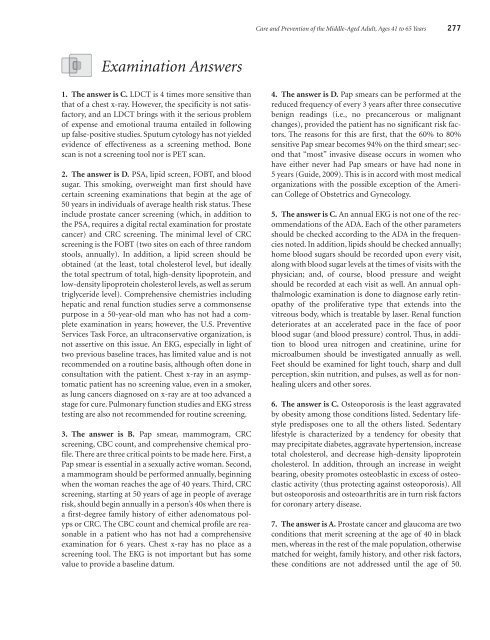NMS Q&A Family Medicine
NMS Q&A Family Medicine
NMS Q&A Family Medicine
- No tags were found...
Create successful ePaper yourself
Turn your PDF publications into a flip-book with our unique Google optimized e-Paper software.
Care and Prevention of the Middle-Aged Adult, Ages 41 to 65 Years 277Examination Answers1. The answer is C. LDCT is 4 times more sensitive thanthat of a chest x-ray. However, the specificity is not satisfactory,and an LDCT brings with it the serious problemof expense and emotional trauma entailed in followingup false-positive studies. Sputum cytology has not yieldedevidence of effectiveness as a screening method. Bonescan is not a screening tool nor is PET scan.2. The answer is D. PSA, lipid screen, FOBT, and bloodsugar. This smoking, overweight man first should havecertain screening examinations that begin at the age of50 years in individuals of average health risk status. Theseinclude prostate cancer screening (which, in addition tothe PSA, requires a digital rectal examination for prostatecancer) and CRC screening. The minimal level of CRCscreening is the FOBT (two sites on each of three randomstools, annually). In addition, a lipid screen should beobtained (at the least, total cholesterol level, but ideallythe total spectrum of total, high-density lipoprotein, andlow-density lipoprotein cholesterol levels, as well as serumtriglyceride level). Comprehensive chemistries includinghepatic and renal function studies serve a commonsensepurpose in a 50-year-old man who has not had a completeexamination in years; however, the U.S. PreventiveServices Task Force, an ultraconservative organization, isnot assertive on this issue. An EKG, especially in light oftwo previous baseline traces, has limited value and is notrecommended on a routine basis, although often done inconsultation with the patient. Chest x-ray in an asymptomaticpatient has no screening value, even in a smoker,as lung cancers diagnosed on x-ray are at too advanced astage for cure. Pulmonary function studies and EKG stresstesting are also not recommended for routine screening.3. The answer is B. Pap smear, mammogram, CRCscreening, CBC count, and comprehensive chemical profile.There are three critical points to be made here. First, aPap smear is essential in a sexually active woman. Second,a mammogram should be performed annually, beginningwhen the woman reaches the age of 40 years. Third, CRCscreening, starting at 50 years of age in people of averagerisk, should begin annually in a person’s 40s when there isa first-degree family history of either adenomatous polypsor CRC. The CBC count and chemical profile are reasonablein a patient who has not had a comprehensiveexamination for 6 years. Chest x-ray has no place as ascreening tool. The EKG is not important but has somevalue to provide a baseline datum.4. The answer is D. Pap smears can be performed at thereduced frequency of every 3 years after three consecutivebenign readings (i.e., no precancerous or malignantchanges), provided the patient has no significant risk factors.The reasons for this are first, that the 60% to 80%sensitive Pap smear becomes 94% on the third smear; secondthat “most” invasive disease occurs in women whohave either never had Pap smears or have had none in5 years (Guide, 2009). This is in accord with most medicalorganizations with the possible exception of the AmericanCollege of Obstetrics and Gynecology.5. The answer is C. An annual EKG is not one of the recommendationsof the ADA. Each of the other parametersshould be checked according to the ADA in the frequenciesnoted. In addition, lipids should be checked annually;home blood sugars should be recorded upon every visit,along with blood sugar levels at the times of visits with thephysician; and, of course, blood pressure and weightshould be recorded at each visit as well. An annual ophthalmologicexamination is done to diagnose early retinopathyof the proliferative type that extends into thevitreous body, which is treatable by laser. Renal functiondeteriorates at an accelerated pace in the face of poorblood sugar (and blood pressure) control. Thus, in additionto blood urea nitrogen and creatinine, urine formicroalbumen should be investigated annually as well.Feet should be examined for light touch, sharp and dullperception, skin nutrition, and pulses, as well as for nonhealingulcers and other sores.6. The answer is C. Osteoporosis is the least aggravatedby obesity among those conditions listed. Sedentary lifestylepredisposes one to all the others listed. Sedentarylifestyle is characterized by a tendency for obesity thatmay precipitate diabetes, aggravate hypertension, increasetotal cholesterol, and decrease high-density lipoproteincholesterol. In addition, through an increase in weightbearing, obesity promotes osteoblastic in excess of osteoclasticactivity (thus protecting against osteoporosis). Allbut osteoporosis and osteoarthritis are in turn risk factorsfor coronary artery disease.7. The answer is A. Prostate cancer and glaucoma are twoconditions that merit screening at the age of 40 in blackmen, whereas in the rest of the male population, otherwisematched for weight, family history, and other risk factors,these conditions are not addressed until the age of 50.
















